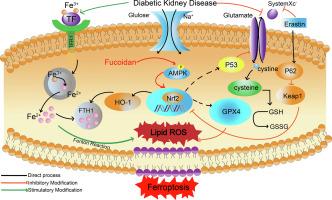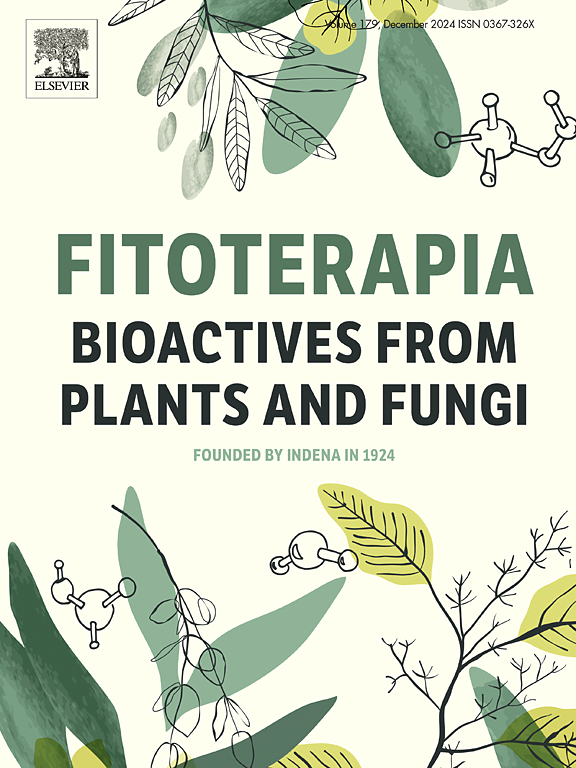低分子量岩藻糖聚糖通过激活SLC7A11/GSH/GPX4改善糖尿病肾病的铁下垂
IF 2.6
3区 医学
Q3 CHEMISTRY, MEDICINAL
引用次数: 0
摘要
铁下垂在糖尿病肾病(DKD)的发展中起着至关重要的作用,并与氧化应激密切相关。低分子量岩藻聚糖(LMWF)已被证明对氧化应激具有抑制作用。在此,我们研究了使用LMWF治疗DKD是否与铁下垂有关,并通过体内和体外模型评估了LMWF对DKD的作用。采用高糖高脂饮食联合链脲佐菌素建立体内DKD模型,采用H&;E、Masson染色观察肾脏病理变化及胶原沉积。我们评估了GSH、GSSG和MDA来评估氧化应激,并利用代谢组学来探索潜在的作用途径。采用普鲁士蓝染色、4-HNE、LPO分析、PCR法检测肾铁下垂。我们的研究结果表明,LMWF抑制DKD的进展,同时降低MDA含量,增加GSH含量,代谢组学分析表明,铁下垂是这种作用的潜在机制。普鲁士蓝染色、4-HNE、LPO和PCR检测进一步证实了这一结论。我们建立了高糖处理HK-2细胞的体外模型,并用LMWF进行干预;这表明LMWF通过降低ROS表达和抑制细胞凋亡在体外具有治疗作用。为了探讨铁凋亡诱导剂(Erastin)干预后LMWF的作用机制,通过western blot分析发现LMWF通过Nrf-2/Keap-1和SLC7A11/GSH/GPX4信号通路抑制DKD。本文章由计算机程序翻译,如有差异,请以英文原文为准。

Low-molecular-weight fucoidan ameliorates ferroptosis in diabetic kidney disease through SLC7A11/GSH/GPX4 activation
Ferroptosis plays a crucial role in the development of diabetic kidney disease (DKD), and it is closely associated with oxidative stress. Low-molecular-weight fucoidan (LMWF) has been shown to exert an inhibitory action on oxidative stress. Herein, we investigated whether using LMWF to treat DKD is associated with ferroptosis and evaluated the action of LMWF on DKD using both in vivo and in vitro models. The in vivo DKD model was established by administering a high-glucose and high-fat diet combined with streptozotocin, and H&E and Masson staining were used to observe pathological changes in the kidney and collagen deposition. We assessed GSH, GSSG, and MDA to evaluate oxidative stress and utilized metabolomics to explore potential pathways of action. Prussian blue staining, analysis of 4-HNE and LPO, and PCR array for ferroptosis detection were adopted to observe renal ferroptosis. Our results indicated that LMWF inhibited the progression of DKD while reducing MDA content and increasing GSH content, and metabolomic analysis showed that ferroptosis was the potential mechanism responsible for the effect. Prussian blue staining and 4-HNE, LPO, and PCR assays further confirmed this conclusion. We constructed an in vitro model of HK-2 cells treated with high glucose and intervened with LMWF; this demonstrated that LMWF achieved therapeutic effects in vitro, as LMWF reduced ROS expression and inhibited apoptosis. To investigate the mechanism of action of LMWF treatment after intervention with a ferroptosis inducer (Erastin), western blot analysis and showed that LMWF inhibited DKD through Nrf-2/Keap-1 and SLC7A11/GSH/GPX4 signaling pathways.
求助全文
通过发布文献求助,成功后即可免费获取论文全文。
去求助
来源期刊

Fitoterapia
医学-药学
CiteScore
5.80
自引率
2.90%
发文量
198
审稿时长
1.5 months
期刊介绍:
Fitoterapia is a Journal dedicated to medicinal plants and to bioactive natural products of plant origin. It publishes original contributions in seven major areas:
1. Characterization of active ingredients of medicinal plants
2. Development of standardization method for bioactive plant extracts and natural products
3. Identification of bioactivity in plant extracts
4. Identification of targets and mechanism of activity of plant extracts
5. Production and genomic characterization of medicinal plants biomass
6. Chemistry and biochemistry of bioactive natural products of plant origin
7. Critical reviews of the historical, clinical and legal status of medicinal plants, and accounts on topical issues.
 求助内容:
求助内容: 应助结果提醒方式:
应助结果提醒方式:


